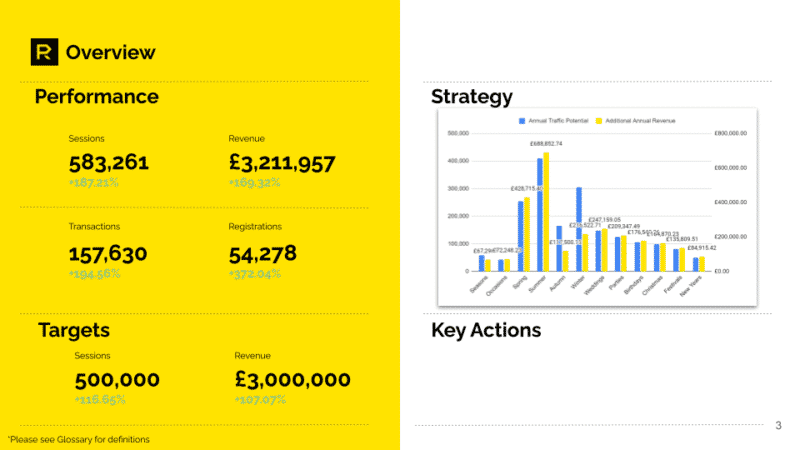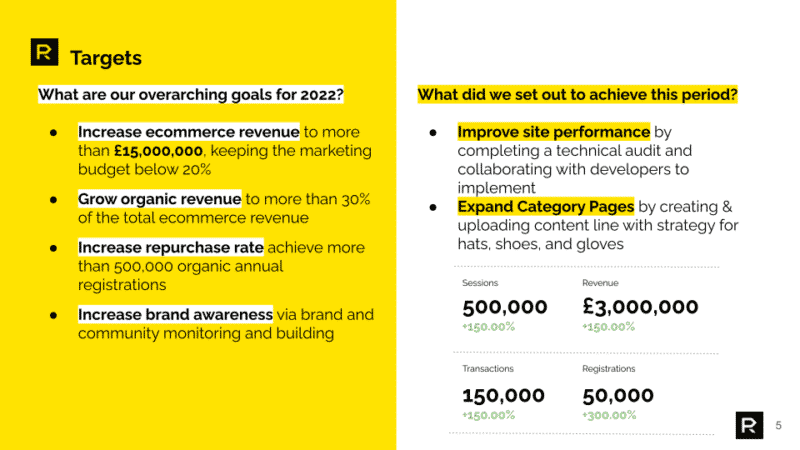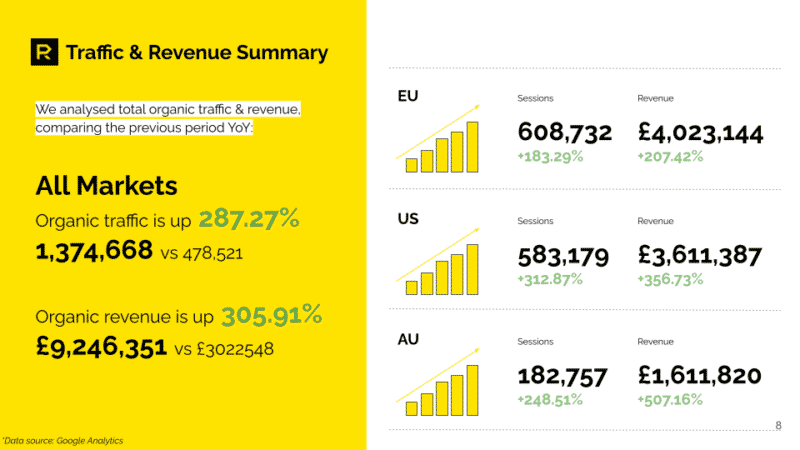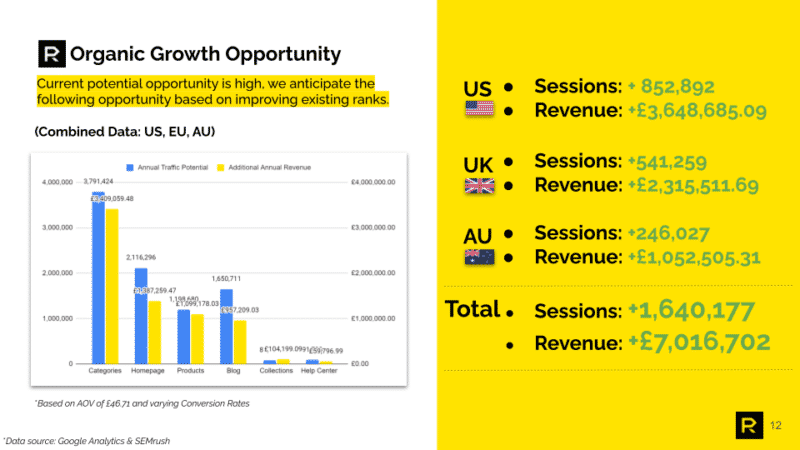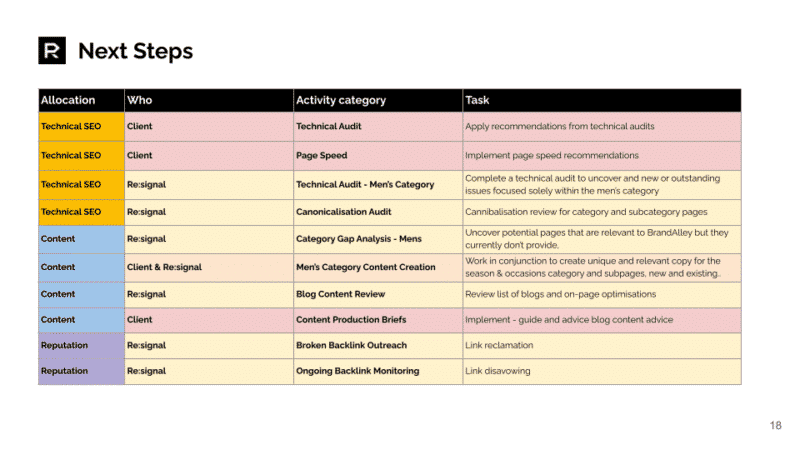How to Write an SEO Performance Report for Your Clients – Key Questions and Free Template!
Whether you’re an SEO agency, or an in-house specialist, There will come a time when you’ll be asked to create a performance or progress report to show your worth. For many this can seem a daunting, and lengthy process, But have no fear! We’ve got some top tips on client reporting best practices and an easy formula you can follow to write a report your clients will love.
What is SEO Performance Reporting?
SEO reporting is presenting a website’s SEO status, generally through month-on-month, quarter-on-quarter, or year-on-year comparisons. It should include data reflecting directly back to your targets and goals for organic performance. These types of reports are for communicating progress on SEO projects, and should be used to ensure all parties have a clear understanding of what progress looks like. This will cover where you’re heading, with a definitive strategy for the upcoming period. An SEO Performance Report should not include an overwhelming amount of screenshots from Google Analytics and GDS Dashboards, as the client can already access and see this data.
Here are the key questions we need to ask ourselves at the start of every report.
Who is Reading My Report, and What Do They Care About?
A common mistake when creating a website SEO report is to overload it with information. This is probably because you’re tracking too many metrics, some of which your client may not even be interested in. You want to avoid including tables with tonnes of data, and anything that isn’t pertinent to your targets.
It is important to tailor your reports to display the metrics that are important to your targets, So naturally this will vary depending on industry and client needs. Understanding your SEO client, and their role within the company is key to creating a great report. So your client status report should be aimed towards the people receiving it!
What you include in your report must be relevant to the targets and KPIs set out. It is important to keep these in mind when assembling your reports. An ecommerce client will likely want to see data round revenue, sales and conversions, whilst a client within the travel sector is more inclined to take a fancy to impressions, sessions and engagement. Tailoring your report for client-specific needs will mean your client will stay engaged and absorb the information. Once you understand who you are creating the report for, you will know what to, and what not to, include. And, always keep your reports streamlined and simple!
What Key Information Should I Always include?
Every SEO report will be slightly different in regard to the information required, but generally speaking, there are some key pieces we should always include. These boil down to the following areas:
- Information on work conducted
- SEO analytics performance
- A reflection against your targets
- An insight into upcoming tasks/trends
It is important to include what you are tracking against previous performance and your targets, in addition to what tasks you have completed. This will allow your client to understand the process and how this will achieve growth and meet their goals, as well as insight into where they’re heading organically. By including what it is you’ll be working on next, and what new trends are developing, you’ll set expectations for the upcoming work, allowing for clear and concise communication of the road ahead. Your clients will appreciate this visibility on what’s to come, as well as the link back to the original targets set!
How should I Structure My SEO Performance Report?
So we now know who will be reading your report and the information they want to see, but how do we structure and present that information in an easy-to-understand way? A good SEO report always tells a story, following a logical and relevant order to present the information. This helps keep the audience engaged, and display the data in an easy to digest format.
Here’s a handy formula for creating an easy-to-follow report:
SEO Report Template
Structure your SEO report in this order:
Tear Sheet
All great reports, whether for SEO or otherwise, will include what’s called a tear sheet. We’re all guilty of being presented a report in a meeting, and forgetting it by the next. A tear sheet highlights the most important metrics from the report, covering all topics discussed and the key focal points from the presentation. This summary sheet will contain progress and strategy at a glance, with minimal text on page, but maximum relevant information. These help all participating parties to have a simple, easy to digest overview of the presentation.
Objectives
What is the purpose of the SEO project? What did you set out to achieve during this period? What deliverables have you achieved this period? This is your opportunity to discuss your clients business goals as a whole, and ensure they’re aligned with your strategy for their business. You will want to highlight the targets you had for the previous period, and what measurable metrics needed to be achieved. This is also a chance to revisit your KPIs, with your client, for the period you’re reporting on and the upcoming period. It is important to discuss these regularly with your client, as they are the key indicators on how we measure ourselves against our targets. Being clear and concise on what success looks like will help keep you on the track to delivering the best SEO strategy possible.
After having clarified and discussed your existing and future KPIs, you should reflect on the work conducted within the period you’re presenting on. This shouldn’t be too granular, and should only highlight tasks from your defined strategy that directly reflect on your KPIs.
Performance & KPIs
Now everyone is clear on the objectives and KPIs for this period, it is time to show how you’re performing against them. Include snippets of data that highlight your wins during this period, these should reflect well against your KPIs. This is a great chance to scream and shout about your success and wins, however you don’t want to include excess data for every tiny performance increase, you can link to respective data sources with more information. This is for the big highlights, anything that is above and beyond your goals and expectations needs to stand out. Remember, the client can access their GDS Dashboard and Google Analytics if they want a more granular look. This is also a chance to report on outstanding performance of specific target keywords, collections, categories, or any metrics that reflect work previously conducted.
Keep this information sleek and simple, if you find you are repeating yourself from slide to slide, try and condense the information down to a single slide. For example, if you are tracking the organic sessions and revenue for multiple countries, or markets, rather than giving each of these an individual slide, these can be combined to give a top level overview of how each is performing. That being said, if there are any unique details you want to mention from a specific market(s), don’t be afraid to talk about it, or have a dedicated slide for it,
Strategy
You know your targets for the previous period, and how you’ve performed against them, you also know your KPIs for the next period. So, now it’s time to identify a clear and definitive path and direction going forward. It is important to highlight the opportunity that you have identified for your strategy. This may be technical, on-page, new content, or off-page, but this is your chance to justify why you’re doing the work you are. This allows your client to understand the purpose and reasoning behind your work, whilst also offering them a platform to share their thoughts.
When presenting the opportunity to your client, you will also want to ensure they’re aware that you have prioritised your upcoming work based on what’s available. It is also worth considering seasonal and upcoming trends that may impact the market you target, as this can impact your strategy. A good format for displaying a clear and concise strategy is through a roadmap. For example, if the focus of your work for the upcoming period is content, then create a content specific roadmap, which will give defined deliverables, deadlines, and details on the road ahead in a clear and easy to understand format.
Next Steps
To conclude your presentation, you must review and summarise the key actionable elements from the strategy for the upcoming period. These should be tailored to your client’s wants, needs and objectives. A simple and concise way to display this data is to breakdown the top 3 key points from the strategy, and highlighting the importance, and deliverables/tasks that are anticipated. This strategy should relate back to everything presented in the report, and include details of:
- expected deliverables
- how the deliverables relate to your KPIs
- performance and tracked metrics
- the opportunity identified
Including a roadmap at this stage will also help to create a clear and concise plan of what the client can expect, and what you and your team will be working on. Be sure to keep this detailed, if you are focusing on multiple markets, languages, or other factors that will be delivered at varying dates, then highlight exactly when each will be delivered. The final slide of the presentation should run through the deliverables for the upcoming period, and any obstacles you may face. This is when you get to chase your client for anything you may be waiting on them for, whether this is implementation, sign-off, or any other reason.
Now you know how to create an SEO performance report that is easy to create, and your clients will love. Just remember, understand the purpose of your report, know your audience, know your targets, and keep it streamlined and simple. Your clients will stay engaged, they’ll see all the great work you’re doing, and they’ll be looking forward to the next one!





